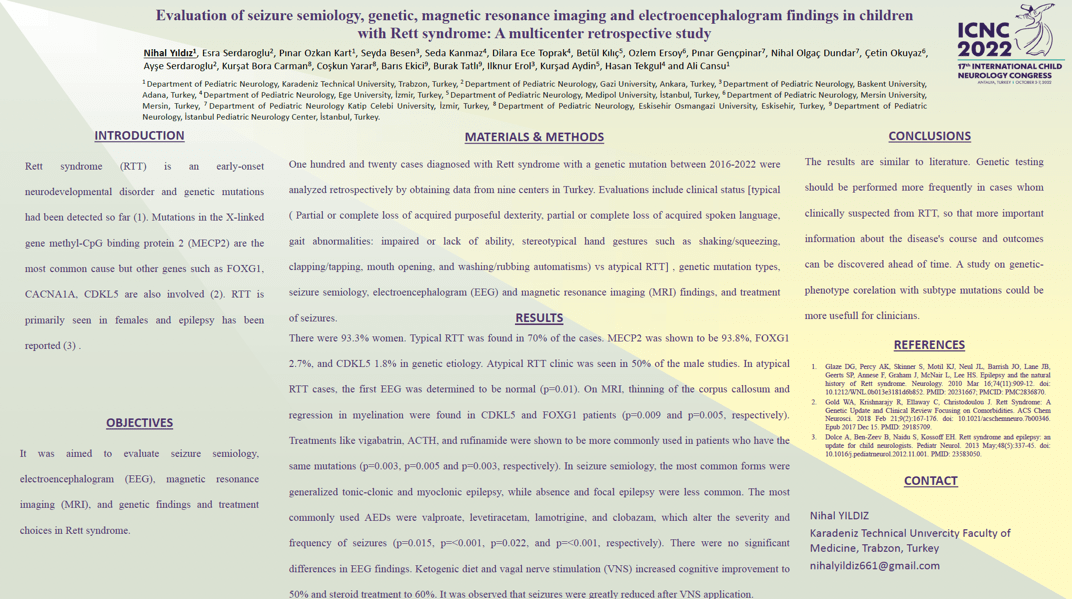Evaluation of seizure semiology, genetic, magnetic resonance imaging and electroencephalogram findings in children with Rett syndrome: A multicenter retrospective study
Nihal Yıldız, Esra Serdaroglu, Pinar Ozkan Kart, Seyda Besen, Seda Kanmaz, Dilara Ece Toprak, Betul Kilic, Ozlem Ersoy, Pinar Gençpinar, Baris Ekici, Nihal Olgaç Dündar, Çetin Okuyaz, Ayse Serdaroglu, Kursat Bora Carman, Coskun Yarar, Burak Tatli, Ilknur Erol, Kursad Aydin, Hasan Tekgul, Ali Cansu
Objectives: It was aimed to evaluate seizure semiology, electroencephalogram (EEG), magnetic resonance imaging (MRI), and genetic findings and treatment choices in Rett syndrome. Methods: One-hundred-twenty cases diagnosed with RTT with a genetic mutation were analyzed retrospectively, by obtaining data from nine centers. Results: In the study 93.3% of patients were female. Typical RTT was found in 70% of the cases. MECP2, FoxG1, and CDKL5 were seen in genetic etiology (resp; 93.8%, 2.7%, and 1.8%) Atypical RTT clinic was seen in 50% of the male studies. In atypical RTT cases, the first EEG was determined to be normal (p=0.01). In seizure semiology, the most common forms were generalized tonic-clonic and myoclonic epilepsy, while absence and focal epilepsy were less common. The most commonly used AEDs were valproate, levetiracetam, lamotrigine, and clobazam, which alter the severity and frequency of seizures (p=0.015, p=<0.001, p=0.022, and p=<0.001, respectively). There were no significant differences in EEG findings. Comparison of the data before and after initiation of anti-seizure medications is given in Table-1. Ketogenic diet and vagal nerve stimulation (VNS) increased cognitive improvement to 50% and steroid treatment to 60%. It was observed that seizures were greatly reduced after VNS application. Conclusion: RTT cases with the clinical diagnosis are needed to investigate the importance of genetic diagnosis. These results are the results of a preliminary study and clinically diagnosed RTT will be included in our study.
Keywords: child, genetic variants, Rett syndrome, epilepsy
Nihal Yıldız
Turkey
Esra Serdaroglu
Turkey
Pinar Ozkan Kart
Seyda Besen
Turkey
Seda Kanmaz
Turkey
Dilara Ece Toprak
Turkey
Betul Kilic
Turkey
Ozlem Ersoy
Turkey
Pinar Gençpinar
Turkey
Baris Ekici
Turkey
Nihal Olgaç Dündar
Turkey
Çetin Okuyaz
Turkey
Ayse Serdaroglu
Turkey
Kursat Bora Carman
Turkey
Coskun Yarar
Turkey
Burak Tatli
Turkey
Ilknur Erol
Turkey
Kursad Aydin
Turkey
Hasan Tekgul
Turkey
Ali Cansu
Turkey
Objectives: It was aimed to evaluate seizure semiology, electroencephalogram (EEG), magnetic resonance imaging (MRI), and genetic findings and treatment choices in Rett syndrome. Methods: One-hundred-twenty cases diagnosed with RTT with a genetic mutation were analyzed retrospectively, by obtaining data from nine centers. Results: In the study 93.3% of patients were female. Typical RTT was found in 70% of the cases. MECP2, FoxG1, and CDKL5 were seen in genetic etiology (resp; 93.8%, 2.7%, and 1.8%) Atypical RTT clinic was seen in 50% of the male studies. In atypical RTT cases, the first EEG was determined to be normal (p=0.01). In seizure semiology, the most common forms were generalized tonic-clonic and myoclonic epilepsy, while absence and focal epilepsy were less common. The most commonly used AEDs were valproate, levetiracetam, lamotrigine, and clobazam, which alter the severity and frequency of seizures (p=0.015, p=<0.001, p=0.022, and p=<0.001, respectively). There were no significant differences in EEG findings. Comparison of the data before and after initiation of anti-seizure medications is given in Table-1. Ketogenic diet and vagal nerve stimulation (VNS) increased cognitive improvement to 50% and steroid treatment to 60%. It was observed that seizures were greatly reduced after VNS application. Conclusion: RTT cases with the clinical diagnosis are needed to investigate the importance of genetic diagnosis. These results are the results of a preliminary study and clinically diagnosed RTT will be included in our study.
Keywords: child, genetic variants, Rett syndrome, epilepsy
Nihal Yıldız
Turkey
Esra Serdaroglu
Turkey
Pinar Ozkan Kart
Seyda Besen
Turkey
Seda Kanmaz
Turkey
Dilara Ece Toprak
Turkey
Betul Kilic
Turkey
Ozlem Ersoy
Turkey
Pinar Gençpinar
Turkey
Baris Ekici
Turkey
Nihal Olgaç Dündar
Turkey
Çetin Okuyaz
Turkey
Ayse Serdaroglu
Turkey
Kursat Bora Carman
Turkey
Coskun Yarar
Turkey
Burak Tatli
Turkey
Ilknur Erol
Turkey
Kursad Aydin
Turkey
Hasan Tekgul
Turkey
Ali Cansu
Turkey

Nihal Yıldız
Turkey
Turkey